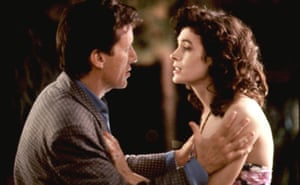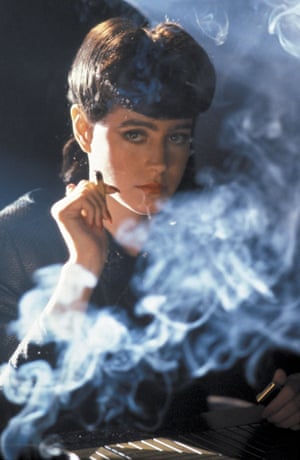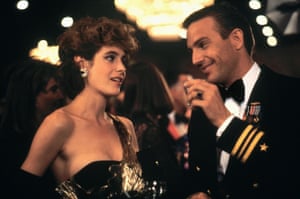 |
| Sean Young: ‘Why are the dudes that run Hollywood incapable of honouring the women any more?’ Photograph: Scott McDermott/Corbis Outline |
Interview
Blade Runner’s Sean Young: ‘If I were a man I’d have been treated better’
The star famous for playing the femme fatale Rachael in Ridley Scott’s sci-fi classic has had many ‘troubled moments’ since – including lawsuits, booze addiction and some unpleasant co-stars. So what is it like to be on the outside of Hollywood looking in?
DANNY LEIGH
THU 26 MAR 2016
“Please don’t write shit about me, OK?” This is how the last email that I get from Sean Young ends, the one where she says she regrets ever writing to me.
The actor emailed for the first time the week before, responding to a request for an interview. It had taken some nudging to elicit a reply. She was, she said, busy with a play, but email was doable. “Try to be brief because I get way too many emails in general LOL,” she wrote, “[but] I can try and help you out.”
I wanted to write about Young for all sorts of reasons, but the most pressing was the re-release of Blade Runner. Ridley Scott’s 1982 sci-fi opus has had no end of breathless words spent on it down the years, but Young – who stars as the beautiful “replicant” Rachael – has never claimed many of them. Which is strange: the movie wouldn’t be the same without her.
Rachael will for ever be her defining role, but she had, for a time, a full career beyond it. For much of the 80s, Young was a bona fide movie star, a poised brunette with a fragile edge. Though her films weren’t always great, she was never less than interesting in them. She was hired by directors including David Lynch, Oliver Stone and Gus Van Sant as well as, on different occasions, both halves of the Merchant-Ivory partnership. It was a life lived at Cannes, the Oscars, in front of flashbulbs.
She is now 55. Though she works regularly, her films rarely involve red carpets. In the past decade only one of her films has had a US cinema release: a low-budget rustic horror called Jug Face. Otherwise, the answer to the question of “where is she now?” is a rented apartment in Astoria, Queens. The play is a six-week run of the comedy Vanya and Sonia and Masha and Spike being staged in a town called Northport, an hour’s drive from New York, population 7,401.
I send back eight questions, trying to meet her request for brevity. I ask if there are current film-makers she admires, her view on the proposed Blade Runner sequel. Near the end, I mention the “troubled moments” of her life. Her reply arrives almost instantly. She promises to think about my questions, but she has a query first. “There have been a few,” she writes, “so I’m just curious which ones you are interested in hearing from me about?” Which ones is underlined.
It would be hard to write about Young without getting here eventually. The reason people’s eyes widen when I tell them I’m in touch with her is not Blade Runner, but this stuff. Principally, there was the legal conflict with actor James Woods, who in 1988 accused her of exotic harassments including leaving a disfigured doll outside his home in Beverly Hills. But there have been, as she says, other calamities – messy run-ins with co-stars and directors, public unravellings. In the online age you can watch her release from a Hollywood police station on Oscar night 2012, dressed in a floor-length black gown. She had slapped a security guard who was removing her from the official after-party when she was found without a ticket.
I try to be specific without being cruel. But I tell her I want to know about it all – because it all became, in the customary telling, the Sean Young story.
I try to be specific without being cruel. But I tell her I want to know about it all – because it all became, in the customary telling, the Sean Young story.
Silence descends. While I wait to find out if the interview is over, I watch Blade Runner properly for the first time in years. Young was 22 when she starred in it. Rachael was only her third acting job. She enters as a pristine gleam of black hair and ruby lipstick. In a film that relocates noir to a dank future LA, she is a bio-engineered femme fatale, a sci-fi dame in 40s shoulder pads.
In the hands of another actor, she could have just been one more detail in Scott’s design scheme, a clothes horse in a coil of cigarette smoke. But Young makes Rachael breathe. It’s a tricky role: she must seem slickly artificial, while hinting all the time at warm humanity. As Harrison Ford’s jaded ex-cop Deckard falls for her, the whole film hinges on us understanding why. That she pulls it off owes a lot to her raw presence – but presence is the lifeblood of movies.
Eventually, she replies. “My dear Danny,” she begins. “To say that I was unfairly targeted is an understatement. But the more interesting question is why?”
The email runs to 1,693 words. Half of those concern James Woods. They met on a forgotten film called The Boost, playing a cocaine-addicted married couple. At the end of an alleged on-set affair, Woods sued Young for harassment; she still insists there was no affair and no harassment. They eventually settled out-of-court. She was awarded $227,000 to cover her legal costs. But the flamboyant nature of the initial accusations would keep them circulating.
Young was the daughter of two journalists. She grew up in Cleveland, Ohio, then trained as a dancer in New York. Even before Blade Runner, her relationship with Hollywood was uneasy. At the start of her career, she alleges, a mogul behaved “creepily” towards her, then tried to have her blackballed after she rejected him. Later, there was Oliver Stone’s Wall Street. Young was cast as the wife of banker Gordon Gekko; after butting heads with Stone and co-star Charlie Sheen, she was removed from the set, and her part cut to almost nothing.
Yet she still had currency enough to win the prize role of Vicki Vale in Tim Burton’s Batman. A week before the shoot, rehearsing a scene on horseback, she fell and broke her shoulder. The part was taken by Kim Basinger. The film was a box-office juggernaut. (In the end, the riding scene was never filmed.) Perhaps understandably, she took aim at a role in the sequel Batman Returns. Her keenness was such that she gatecrashed the Warner Brothers studio lot in a homemade Catwoman costume, demanding to see Burton. After the original stroke of woeful luck, it was a follow-up of haunting misjudgment. The press were not kind. By then, the Woods story was out there too. There was another lost role, when Warren Beatty sacked her from 1990’s Dick Tracy after, she says, she declined his advances (Beatty denied it). The media, naturally, took all that she could give. Her name became a punchline, shorthand for a certain kind of aggravation. The industry began to close doors, and her career went into a death spiral. As the 90s went by and her 20s with them – the age when roles dwindle even for orderly female actors – she “limped” into TV movies and bad horror films. “I did some films I wasn’t particularly pleased about, but I had to earn a living.” By then she had left Los Angeles for Arizona, and had her two children.
In 2008, director Julian Schnabel found himself being heckled while making an acceptance speech at the Director’s Guild of America awards. Footage shows him peering unhappily from the stage. “Have another cocktail,” he scowls when he sees the culprit. Young was, she admits, “pissed (pun intended)”. She doesn’t mention any grudge against Schnabel, just a generalised rage at having been “shelved and discredited by people who didn’t like that I was deeply honest [and] an unavailable prude who, at times, had a big mouth”.
She was also just pissed. Admitting to an alcohol problem, she went into rehab. It didn’t take. Three years later, she appeared on a reality TV show called Celebrity Rehab. It was, she says, her personal low. “Except for the fact that I could retire on the money and I only had to work for 10 days: that part was good.” This is also underlined. (After the Oscar arrest in 2012, she insisted she was sober.)
That was what I meant by the Sean Young story. Actually, she doesn’t agree: “Honestly Danny boy, I’m not sure what you are calling the Sean Young story because if you go ask any normal person walking the street they will most often say: ‘I LOVE her.’” Still. In this one email she is sometimes sad and sometimes dry, but it’s the fury that stands out – the hot memory of having been wronged by people she calls “pigs”.
She has only answered one question. I email back, and ask if she has time, whether she could answer the rest. She asks me to remind her what they were.
That night, I re-watch two of her other films, the ones that don’t get the attention of Blade Runner. In 1987’s No Way Out, she glints brilliantly in a Hitchcocky confection. In The Boost: she’s raw, compelling. Really, these past couple of decades, it’s Hollywood’s loss as well as hers. The play in Northport, I find, has been reviewed in the New York Times. Young, despite minimal stage experience, is said to “acquit herself honorably”.
It’s strange, how the Blade Runner legend now leaves out both Young and her co-star Daryl Hannah, presenting it as the collective triumph of Ford, Rutger Hauer with his “tears in rain” speech, and Ridley Scott orchestrating it all. Then again, that kind of thing often blights actors. Like a lot of what befell Young, it could only have happened to a woman.
The past is unknowable. But the idea that a young female actor new to Hollywood would be directed to the casting couch is hardly outlandish, or that the same actor would face the same demands even as a star. On-set, male actors can scream abuse at underlings and have it passed off as being “driven”; making Wall Street, an unwitting Young had a sign reading “cunt” stuck to her back by Sheen. And when the media reported her trials, they did so with the particular pursed delight that greets a woman’s fall from grace.
As for Hollywood, it often finds it easier to give second acts to men. Young could be excused a smile on noting that the highest paid actor in Hollywood for the past two years has been Robert Downey Jr, whose struggle with drug addiction in the 90s saw him spend time in state prison, as well as mistaking a neighbour’s house for his own and falling asleep in a child’s bedroom.
There are probably too many stories about Young’s “theatricality” for them all to be untrue. In the course of our email exchange, I am not always struck by the urge to get stuck in a lift with her. She admits to a “knack for pissing people off.” It is also rude to heckle someone while he’s collecting an award. But it’s unlikely any of this was helped by how the industry treated her. And she can be funny, and self-aware, and if even half those stories were embellished, and just some of that treatment was down to sheer misogyny – well, that’s quite a bum rap. You’d be angry too.
The next email she sends is shorter, and less sandpapery. She says that she will have no role in the Blade Runner sequel: “I saw Ridley a month ago and not a peep was uttered from his mouth about it and so I left it alone.” Her professional interest in new films is limited – “I had to give up … it just hurt too much to care” – but she says she liked Jennifer Aniston’s Cake.
On the subject of women in Hollywood, her response is pure Sean Young. “Of course if I were a man I’d have been treated better. Duh.” She goes on: “Why are the dudes that run Hollywood incapable of honouring the women any more? Maybe it’s because all these dudes were not the first choice of the women of their youths […] But they can make it in tinseltown and perpetuate the desperate delusion that they are powerful.”
She says she has no real hope of a comeback. “It’s like putting a beautiful racehorse out to pasture before her time and then after 20 years expecting her to be the same horse.” Yet she feels “peaceful” now, “happily avoiding the world’s problems in Astoria with my family and my dog”. She has attached a photo of the dog to her email. It stands cheerfully in the New York snow, a white fluffy thing in a knitted orange dog-jumper. “This should do it, right?”
I email to thank her. I mention the Guardian may be in touch to source a photograph, and I tell her the dog is sweet.

“Oh shit, this is for the Guardian?” This genuinely appears the first time she has realised. There is a note of panic and some recrimination. “You’ll probably be the reason I won’t ever do another one of these again.” And then, to end: “I’m sweeter than my dog.”
I check the first emails I sent her, as well as the ones to her agent. They all make it clear who I’m writing for. Pointing this out doesn’t help. “I was written about by the Guardian in 1993 or thereabouts,” she replies, “and it wasn’t a positive experience.” The phrase “character assassination” is mentioned.
(Intrigued, I search the paper’s archive at the British Library. Every mention through the 80s and 90s seems complimentary. Reviews call her “deft” and “deliciously snotty”, her presence in a film a “recommendation”. Finally, I find what must be it – the last item in a 1991 diary column, half a dozen lines, slyly comparing remarks she made about Sheen and Beatty with theirs about her.)
“I regret writing to you now because it is yet another moment where I open my big mouth and give people the ammunition they need to be harmful. But perhaps you’ll have a heart.” She berates herself for what she calls her insufficient boundaries. “Stupid girl. God, when will I learn?” And then she says goodbye: “Don’t write shit about me, OK?”
Later I watch Blade Runner again. After Rachael exits her first scene, her creator Eldon Tyrell discusses her with Deckard. The room feels oddly empty without her. “More human than human is our motto,” Tyrell says.




No comments:
Post a Comment